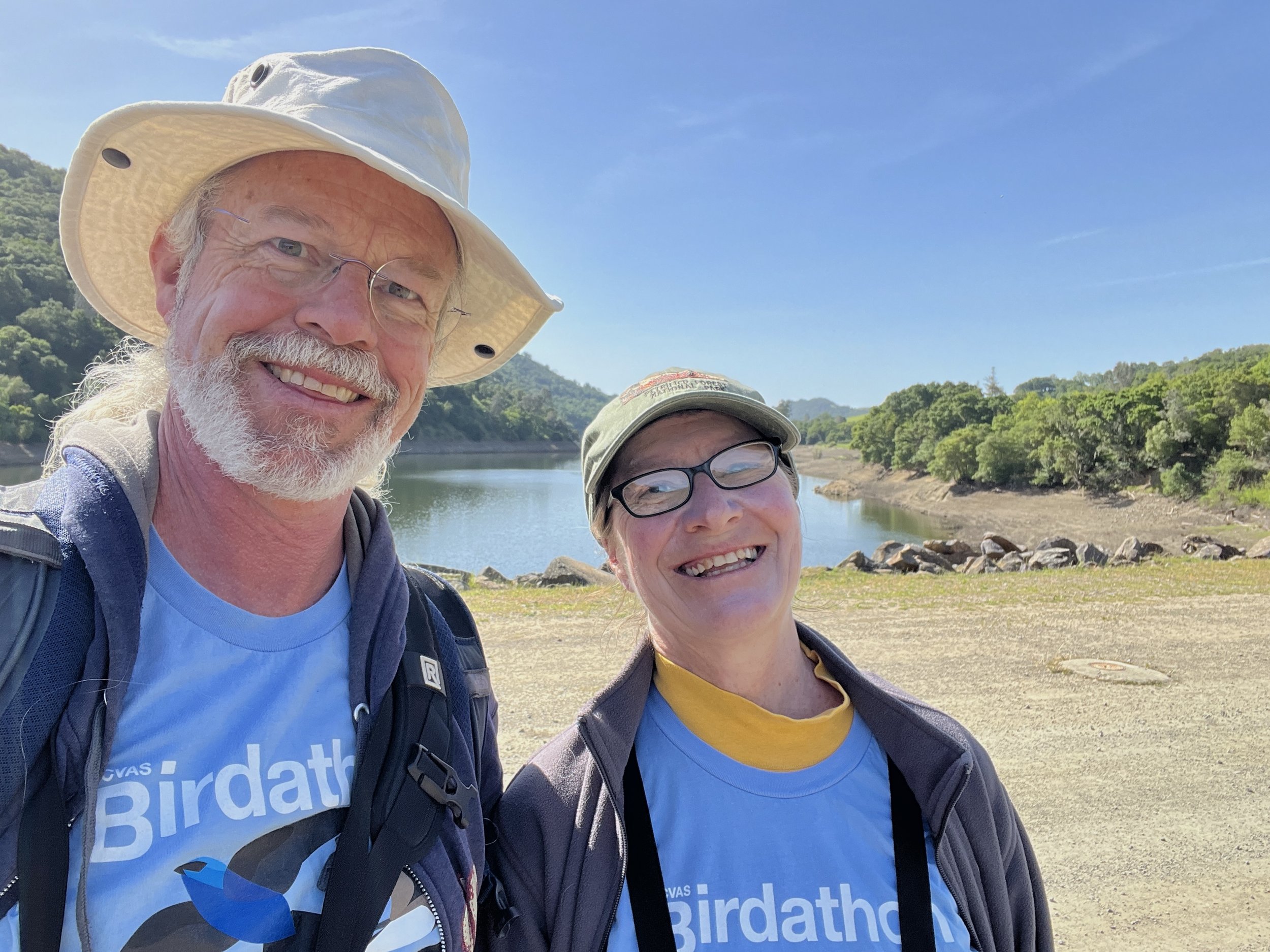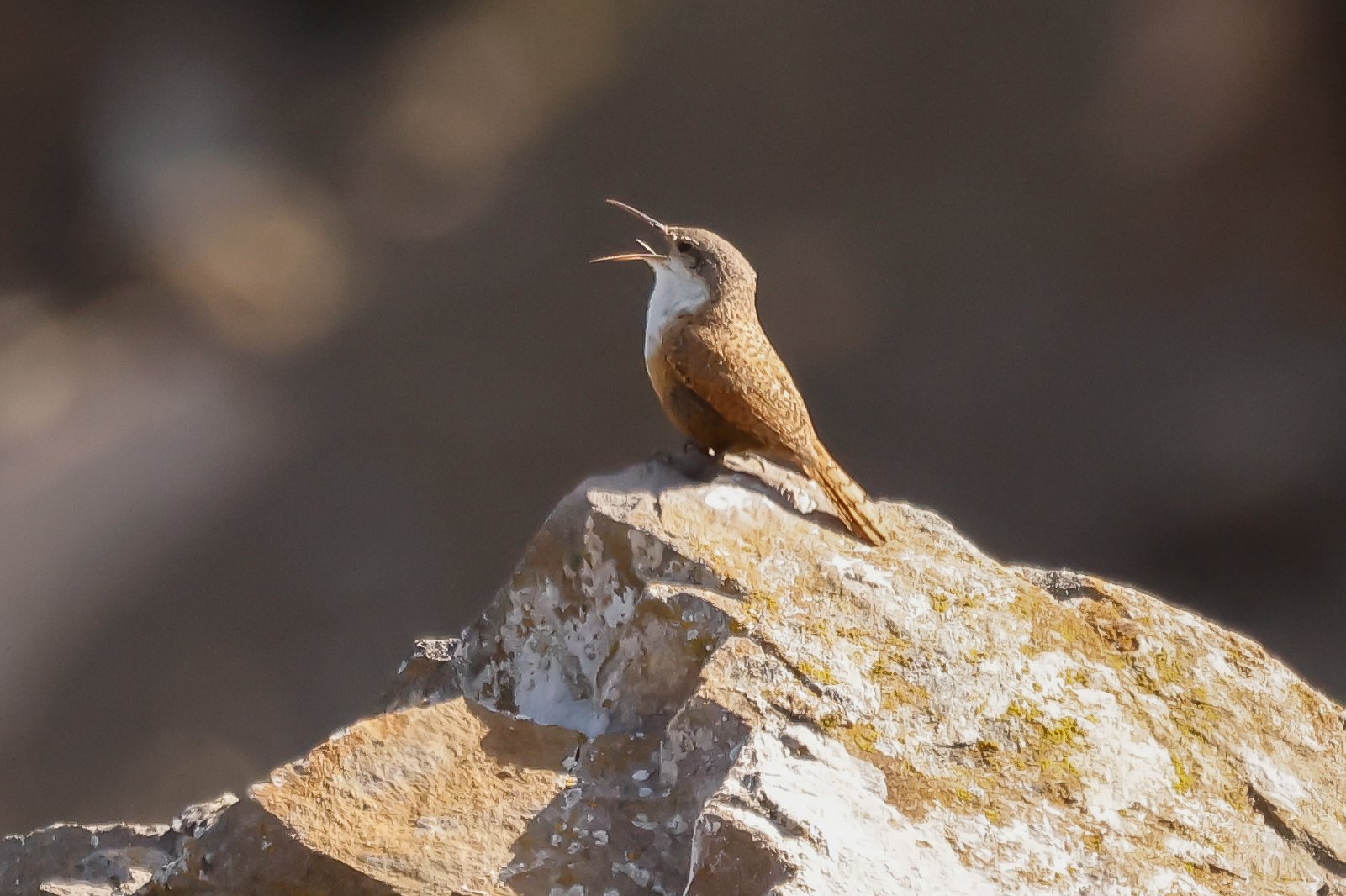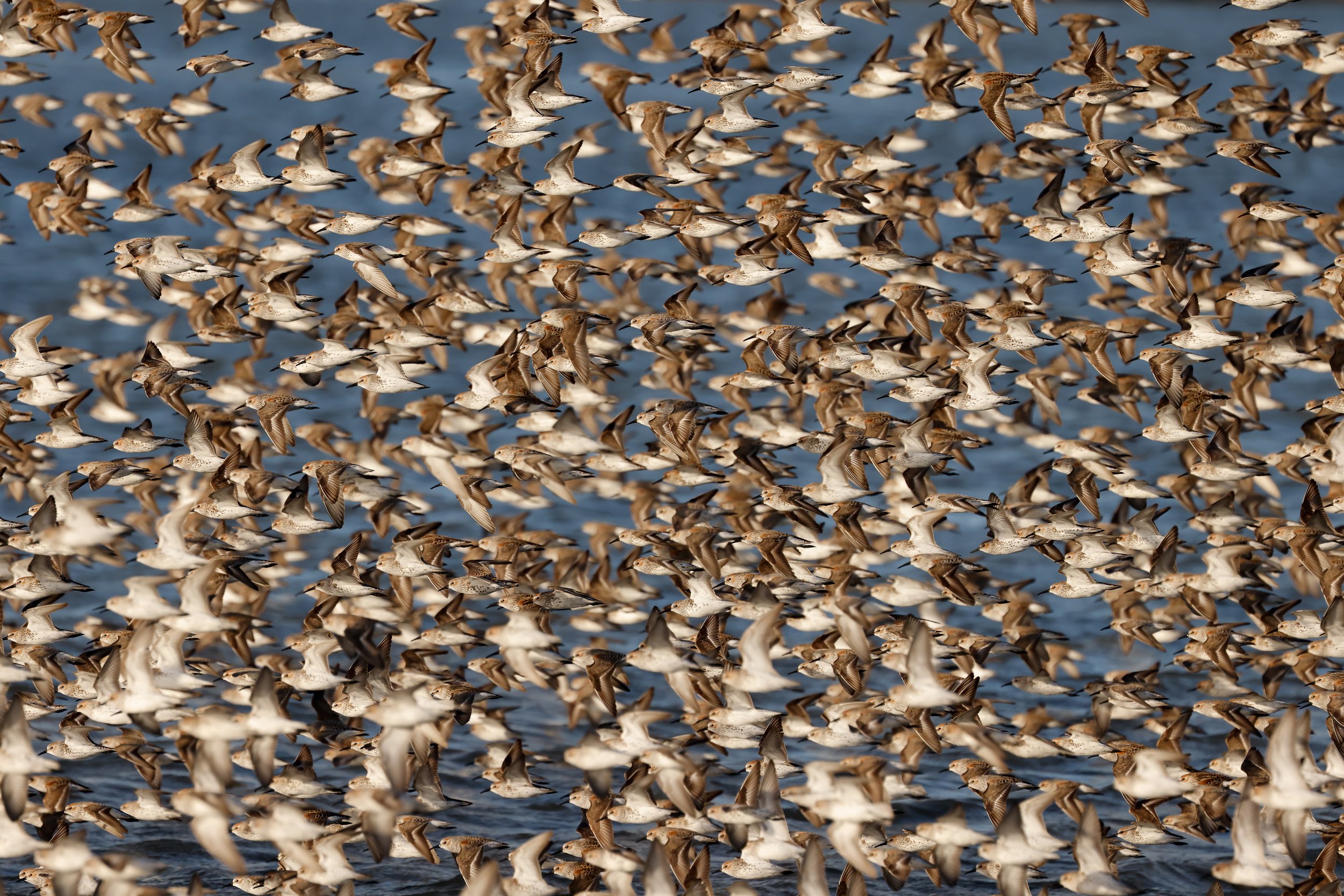Tuesday, 25 April, 2023
Western Screech-Owls make a call reminiscent of a ping pong ball rapidly dropping, with the hoots getting closer and closer until they become a trill. It’s eerie and it’s beautiful and it wakes us up at 1:07am on the day of our Big Day Birdathon. First bird! We are camping in our teardrop trailer on the shores of Coyote Lake in the hills west of Gilroy. Our alarms are set for 5am and thankfully we are able to nod off again fairly quickly after the thrill our nocturnal visitor gives us.
Pre-dawn at the campsite
We’d prepared campsite coffee the night before and cached it in a thermos. Every minute counts and we want to catch the dawn chorus of birds in the hills west of our campsite. We awaken on time, drink a quick cup each and then traipse off in the dark to the trailhead. Our binoculars and camera would be of little use for the first hour or two, but our ears will suffice until the light comes. The woodland birds greet us as the sky brightens and our hearts are filled with the joy and wonder of Nature.
A California Towhee gathering nesting materials (click to zoom)
Where we listened to the dawn chorus
When you’re craning upward in the early morning light to peer into a verdant canopy of Live Oaks, Sycamores and Bay Laurels and Ginger just glimpsed a Hermit Warbler and a rare Hammond’s Flycatcher flies in to see what’s up and a Brown Creeper starts trilling in the hollow, but the sun is rising above the hilltops and your watch insists you’re already behind schedule, it’s hard to move on. “Don’t leave the birds to find the birds,” a friend’s wise advice echoes in our heads. But we need to leave, or else our total count for the day will be twenty four instead of one hundred twenty four. “Just two more minutes,” I insist, ten full minutes before we finally drag ourselves back down the hillside to our campsite where more coffee and our car await to accelerate our pace.
A narrow road meanders along the western border of the reservoir, part of Coyote Lake-Harvey Bear County Park. At its northern end is a dam overlooking a valley where Canyon Wren can be reliably found, or at least heard, as they sing a most enchanting song: notes descending like cascades of water into a rocky valley. We find our wren, boldly perched mid-dam on a sizable boulder, announcing its presence with little regard for our frenzied tallying. Oh! White-throated Swifts flying overhead. Are they nesting in that cliff? Wait, are those Northern Rough-winged Swallows eating fox scat? No, they want the flies that’re buzzing around it. Black Phoebe, my favorite bird, perches atop the park bulletin board, its mate flycatching nearby. Cassin’s Vireo, Warbling Vireo, Wilson’s Warbler, all playing hide-and-seek and calling from the trees and oh yes, that’s a Nashville Warbler! If we stay long enough I can get a photo…but time, always time. Time to leave this spot for the next spot.
Canyon Wren singing
Black Phoebe at Coyote Dam
At the dam, Coyote Lake
Driving out of the park uphill toward the headwaters of Coyote Creek we spy Common Mergansers in the creek and American Robin in a Madrone as we drive. We stop to walk a bit along the roadside bordering the creek, finding a pair of Wood Ducks and two Black-headed Grosbeak and we always want to keep walking and see if maybe there’s one more bird we hadn’t noticed yet. A Western Tanager perhaps? No, not this time, or not in the time we have.
We turn back downhill, stopping at the Mendoza Ranch parking area on the way out of the east hills. There we watch a pair of Yellow-billed Magpies gather sticks to take to their nest-building site as soon as we stop stalking them. A pair of Tree Swallows are flitting atop the stop sign, ready to breed if only we’d avert our eyes. A Western Kingbird lands on the telephone wires; a Northern Flicker calls from the trees on the opposite side of the road. The little pond has pairs of Gadwall and Bufflehead and Ruddy Duck. It must be Spring. And I haven’t even mentioned the flowers, beautiful spring wildflowers blooming at every stop, distracting us from our quest.
Stopping at Mendoza Ranch
Yellow-billed Magpie collecting nest materials (click to zoom)
There’s always a sense of urgency during Birdathons, and constant strategizing to maximize our species count and minimize the time we’re driving. What have we already seen? What did we miss? Where can we go to get more birds in less time? What will traffic be like? What are the tides, the weather? We eat on the go from a snack bag we packed beforehand. We drink more coffee from the thermos and water from our water bottles. We’re always looking out the window in case a hawk soars above us or a passerine flushes from the Coyote Bush close enough for us to identify as we zoom past. But driving time is also valuable for thinking and we use our car-time to strategize.
Red-tailed Hawk
We plot a route that keeps us off the freeways and takes us via backroads past Chesbro Reservoir. There we stop briefly to watch a group of Common Mergansers moving across the lake and hear a Belted Kingfisher call in the willows and our first Wrentit of the day sing on the hillside. We don’t linger though, so next it’s on to Calero Reservoir where we find a pair of young Bald Eagles in a low-key tussle with a Golden Eagle! Nothing seems to come of the interaction; the Golden Eagle soars off and the Bald Eagles settle onto dead treetops on the far edge of the reservoir.
The press of time continues. We forego walking the edge of Calero in hopes of Least Bittern or Tricolored Blackbird—too much time for too small a chance for too few birds. We head to Rancho San Vicente, bathrooms and a hiking trail up green hills to where the Lark Sparrows were singing. We probably linger too long here, but it’s so beautiful.
Ginger on the trail at Rancho San Vicente
Finally we drive toward the Bay, but as we look at our route we realize we can make a quick stop at Lake Almaden, an oasis in the city. On exiting the car Ginger turns on the Merlin Bird ID app to record a sound she’s hearing up the hill: was that a Wilson’s Warbler or a Bewick’s Wren calling? Just as she does so, a Black-chinned Hummingbird dive-bombs her, its distinctive buzz recorded in Merlin for our records. Partway through our explorations we run into SCVAS’s Treasurer Gary Campanella and his wife out for a walk and we exchange hellos. We continue a ways up the creek trail, then cross a bridge to see what else we can find, but Bushtit was the only new bird for the day. We did see a pair of baby European Starlings in a woodpecker hole in a tree, being fed by their parents.
Okay, now it’s time to bolt for the Bay. We take freeways this time, 85 to 101 to San Antonio Road to Terminal Boulevard where we park at the east end to get to Shoreline Lake quickly. It’s 3:45pm. Our plan for the remainder of the day is to keep to the Baylands, with its wetland habitats full of different birds from the hillside forests, savanna and freshwater lakes we explored earlier.
Eared Grebe, Shoreline Lake
On Shoreline Lake we are immediately greeted by a small flotilla of Eared Grebes in their alternate-plumage finery and looking out to the island we see many glorious Black Skimmers with their unique extra-long lower mandible. When they take flight we count at least 30. While scanning the lake for the reliable Surf Scoters (the only place in the county that I know to find them) I see a mysterious white bird on the water, almost at the far shore. “What’s that weird duck?” I ask Ginger, “Is it an Eider or something?” I really had no idea, as I hadn’t been keeping on top of the South-Bay-Birds mailing list so I didn’t know that there was a very rare Long-tailed Duck recently reported there. These birds are found out at sea, rarely inland. Spending precious minutes, we walk all the way around the lake to the playground to get a closer view. The bird seems healthy and it lets us get fairly close for a little photo shoot!
Long-tailed Duck, a county rarity on Shoreline Lake
Black Skimmer above the island at Shoreline Lake
Part of the Shoreline Lake Black Skimmer flock
Our walking takes us to Salt Pond A1 hoping for Canvasback (nope), but we find the subtly-different Clark’s and Western Grebes on the saltwater, and a flock of approximately 200 Marbled Godwits in flight. The path takes us past Charleston Slough, the Forebay and a portion of Adobe Creek where we had hoped to find at least one Black-crowned Night-Heron. There was little there, no sign of the herons which are usually there in good numbers. As we finish the loop, two Green Herons fly over the pathway from one cattail-and-sedge-filled basin to the other.
Clark’s Grebe: white around the eye (click to zoom)
Western Grebe: black near the eye (click to zoom)
Green Heron flying over the trail at Charleston Slough
We hurry back to our car as the clock continues inexorably toward dusk and we take a tour of Palo Alto Baylands. The tide is rising, so we go first to the dock at the end of the road and scan out into the deeper bay, but find nothing new there. The muddy edges of the slough do give us a resting flock of Whimbrel. We drive to the Duck Pond, park and walk the borders of the slough. The water is rising in the flats between the pond and the visitor center and there a giant flock of Western Sandpiper are feeding hurriedly before the mud is inundated. I’m mesmerized by the huge number of birds in such a small area, all in a feeding frenzy, occasionally all taking wing at once as some threat, real or imagined, startles them. The sunlight is golden on the birds and the water; it’s another one of those moments that are really hard to leave.
Western Sandpiper feeding
Western Sandpiper flying
The entire flock of sandpipers takes off as the water rises and that breaks the spell. I turn to see a few Semipalmated Plover fly in and we think we see a Snowy Plover but aren’t sure enough to count it. Leaving, we spy our one and only Long-billed Curlew on the far shore, asleep at first but eventually showing us it’s enormously long bill and the lack of head stripes that help distinguish it from the Whimbrel we had counted earlier.
A quick drive over to Byxbee Park does not yield any of the hoped-for rails. We don’t get out of the car here, we’re getting very weary and we’re hoping to hit a couple more spots before we lose our light. We drive hopefully past a Barn Owl box behind the airport, but apparently the winter storms blew it over; it was leaning at an angle unlikely to be appealing to any owl, at least.
Next was Geng Road where a good number of Hooded Orioles call and fly in the trees above the parking lot. We get Spotted Sandpiper here along San Francisquito Creek, the border between Santa Clara and San Mateo Counties.
Tired as we are, we make one last stop at the Emily Renzel Wetlands, get out and hike the loop around the pond. There we find another Spotted Sandpiper, and our hoped-for Black-crowned Night-Heron. No Sora call. The sun sets. Darkness returns to hide the birds. We head back to the car.
Black-crowned Night-Heron at Emily Renzel Wetlands, our last new bird for the day
Sunset at Emily Renzel Wetlands
Rush hour is over as we drive through the city. We are physically drained and ravenous. We pull into Denny’s in Morgan Hill for our breakfast-for-dinner and to tally the day’s observations. Despite many misses, including the usually omnipresent House Sparrow, we have matched our previous year’s total of one-hundred twenty-four birds! Buoyed by our numbers we use our last burst of energy to drive back to our teardrop where we immediately fall into bed and sleep, only to wake again to the call of the Screech-Owl in the tree above our campsite.
Barry & Ginger Langdon-Lassagne
The Piratical Flycatchers
Our campsite at Coyote Lake
Our eBird Trip list with more (bird) photos can be found here.
Here’s the route we took on our Big Day:
And one more thing…
Epilogue:
The next morning we linger at the campsite. Tree and Violet-green Swallows circle overhead. Ash-throated Flycatchers are clearly nesting somewhere near. The American Crows are waiting to see if we leave scraps of food behind. We slowly clean and pack our things, hook the teardrop up and creep out of the campground. As we drive up and over the hills toward Gilroy we decide that our sore muscles would benefit from a quick hike on one last trail before we go home. We decide to stop at the western entrance to the park. As we get out of the car we cross paths with Eve Meier, SCVAS’s Field Trip leader, and we catch up on each other’s lives. She tells us about her favorite trails at this entrance and we get excited to go exploring. We had never taken these trails before, despite our many years living here.
About a mile, mile and a half, up the trail we hear the high warble of a Lazuli Bunting—a spring arrival we had missed yesterday. We pause in the shade of a Valley Oak as the day has gotten hot and soak in the bird’s song. I look at our map and realize that another “short” mile up the hill runs the Bay Area Ridge Trail, which seems like a great place to turn around. I joke that there will be another new bird at the ridgetop and sure enough, a flock of Chipping Sparrows were flitting among the trees as we crested. We really didn’t expect that bird here—it was yet another delightful surprise. Lark Sparrows, Western Kingbirds, Western Meadowlarks and other savanna specialties were there as well and the view was spectacular. Wildflowers such as Mule Ears, Ithuriel’s Spear and Lupine were blooming on the green hilltops. We can see the lake below us to the east, and can tell where our campsite was. Far to the west is Loma Prieta and Mount Umunhum already silhouetted by the westering sun, and between those hills and our overlook sits the Coyote Valley, mostly agricultural land and wild open space despite its proximity to bustling Silicon Valley, and likely to remain that way due to the unending efforts of SCVAS and other conservation-oriented non-profits in the Santa Clara Valley. We take it all in, then begin to hike back down the trail. It’s hard to leave.
Ha ha! One more one more thing…
Postlude:
It’s 2023, so naturally I asked ChatGPT-4 to reflect on this essay and perhaps transmogrify it into poetry for me. Here’s an AI-generated excerpt of our adventures:
At the break of day, when the clock doth chime,
We look to treetops, losing track of time.
Live Oaks and Sycamores in verdant array,
Ginger spots a Hermit Warbler at play.
A Hammond’s Flycatcher joins the scene,
While a Brown Creeper trills in the hollow green.
The sun doth rise, we are off our pace,
But the birdsong holds us in its embrace.
"Don’t leave the birds to find the birds," a friend did say,
Yet leave we must, lest our count stray.
Two minutes more, I plead the time,
Yet ten minutes later, down the hill we climb.
















